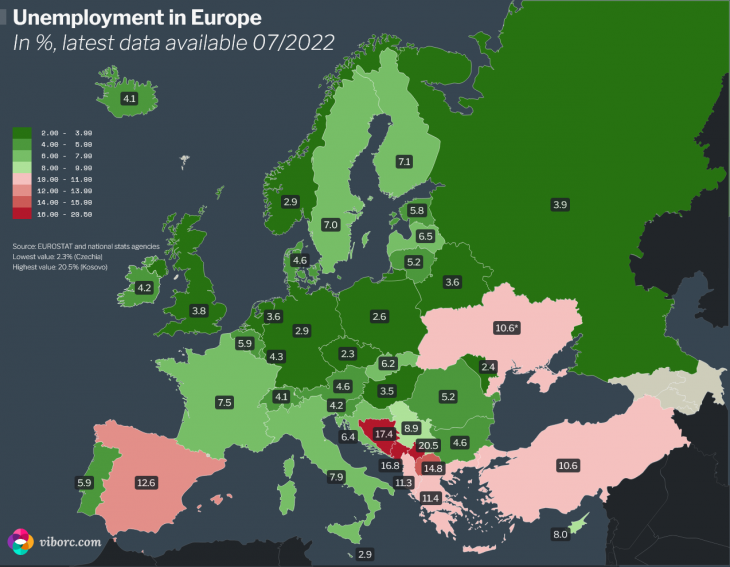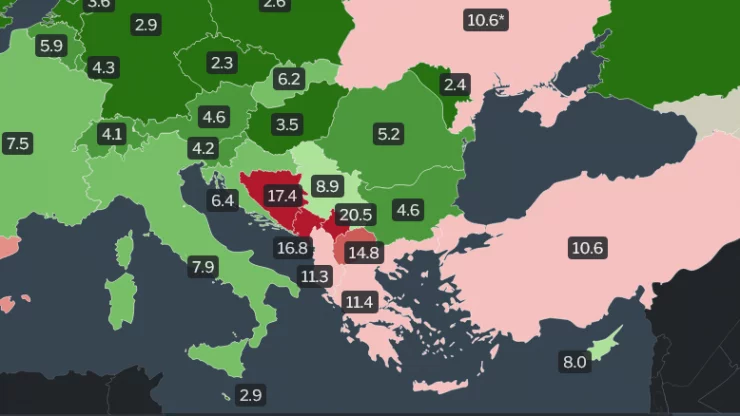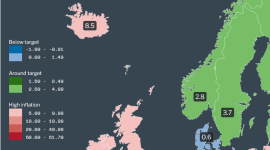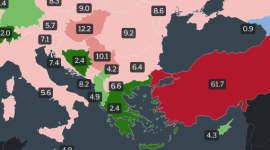Seasonally adjusted data for the euro area shows an unemployment rate of 6.6%, down from 6.7% the month before and 1.1% less than in July 2021 (when it stood at 7.7%).
Looking at the broader picture, the overall unemployment in the EU was 6.0% in July 2022, slightly down from the 6.1% recorded a month earlier and 0.9% down from July 2021, when it stood at 6.9%.
Country data – European Union and Euro-area

The lowest unemployment rate in Europe – Czechia
The Czech Republic‘s unemployment rate of just 2.3 percent is the lowest of any European country. Germany, Malta, and Norway are at 2.9 percent, and Poland stands at 2.6 percent, examples of EU nations with lower unemployment rates than 3 percent.
The highest unemployment rate in Europe – Spain
Spain, which has an unemployment rate of 12.6%, is located at the opposite end of the scale for the EU. Those two nations are the only ones in the European Union with unemployment rates higher than 10 percent, the other being Greece, which has a rate of 11.4 percent.
Greece saw the largest decrease in its unemployment rate from the previous month, June 2022, falling from 12.3 percent to the previously mentioned 11.4 percent.
The unemployment rate rose by the greatest amount from one month to the next in Cyprus, from 7.4 percent in June to 8.0 percent in July 2022. This represents a month-over-month increase of 0.6 percentage points.
Country data for non-EU countries
This section contains data collected for countries outside of the EU. An attempt has been made to use comparable sources (labor force survey; LFS) and to find the latest data available. While some countries, like the UK, Switzerland, and Norway, have up-to-date and easily found data, others, like Bosnia and Herzegovina or Kosovo, have been challenging to find. Not to mention that their data availability is usually several months or even quarters later than the data from the EU countries.
In this section, the data for several regions and countries within them is provided:
- The UK, Switzerland, Norway, and Turkey
- Eastern Europe (with data for Belarus, Ukraine, and russia)
- The Balkans (with data for Albania, Bosnia and Herzegovina, Kosovo, Montenegro, North Macedonia, and Serbia)
- The US and Japan
The UK, Switzerland, Norway, and Turkey
The data for the United Kingdom shows an unemployment rate of 3.8%. The figures for Norway are even better, showing the unemployment at just 2.9%. And lastly, the Swiss data from the end of Q2 2022 shows an unemployment rate of 4.1%.
Turkish statistical institute reports unemployment of 10.6% for the second quarter of 2022, a decrease from 11.0% recorded in the first quarter.
Eastern Europe
The russian data from June 2022 shows record-low unemployment of 3.9%.
While, at the same time, in Ukraine, a country that russia unprovoked invaded, more than 5 million jobs have been lost already. The latest available data based on ILO’s modeled estimate from the end of 2021 points to an unemployment rate of 8.9%, which is surely significantly higher in 2022. The latest data from Ukraine’s statistical office from January 2022 shows the unemployment rate at 10.6%.
The Belarusian unemployment rate for the second quarter of 2022 stands at 3.6%.
The Balkans
This region has Europe’s worst unemployment rates, reaching as high as 20.5% (in Kosovo).
In Bosnia and Herzegovina, the latest available data is from June 2022 and shows staggering unemployment at 30.7%. This is the data from the official statistics office. However, the labor force survey paints a somewhat better picture, with the unemployment rate at 17.4%, according to the latest data published.
In Serbia, the situation is significantly better, and according to the LFS, the unemployment rate is 8.9%. That’s even better than several EU member states like Spain or Greece. However, it’s also far worse than any EU country bordering Serbia (Bulgaria, Croatia, Hungary, Romania).
Data for North Macedonia (Q1 2022) indicates an unemployment rate of 14.8%. The Statistical Office of Montenegro (MONSTAT) published the latest data for Q1 2022, with the unemployment rate at 16.8%.
The latest available data for Kosovo is from Q2 2021 and shows an unemployment rate of 20.5% — the worst result in Europe. Neighboring Albania reports an unemployment rate of 11.3% for the first quarter of 2022.
US and Japan
The data from the United States reveals that the unemployment rate is at 3.5 percent, whereas the figure for Japan is significantly lower at just 2.6 percent. Furthermore, when compared to countries in the EU, Japan’s numbers are comparable to those in Poland, whereas the unemployment rate in the United States is comparable to that in Hungary.
Unemployment rates in Europe, per country
| COUNTRY | UNEMPLOYMENT RATE (%) |
|---|---|
| Albania | 11.3 |
| Austria | 4.6 |
| Belarus | 3.6 |
| Belgium | 5.9 |
| Bosnia and Herzegovina | 17.4 |
| Bulgaria | 4.6 |
| Croatia | 6.4 |
| Cyprus | 8.0 |
| Czechia | 2.3 |
| Denmark | 4.6 |
| Estonia | 5.8 |
| Finland | 7.1 |
| France | 7.5 |
| Germany | 2.9 |
| Greece | 11.4 |
| Hungary | 3.5 |
| Iceland | 4.1 |
| Ireland | 4.2 |
| Italy | 7.9 |
| Kosovo | 20.5 |
| Latvia | 6.5 |
| Lithuania | 5.2 |
| Luxembourg | 4.3 |
| Malta | 2.9 |
| Moldova | 2.4 |
| Montenegro | 16.8 |
| Netherlands | 3.6 |
| North Macedonia | 14.8 |
| Norway | 2.9 |
| Poland | 2.6 |
| Portugal | 5.9 |
| Romania | 5.2 |
| Russia | 3.9 |
| Serbia | 8.9 |
| Slovakia | 6.2 |
| Slovenia | 4.2 |
| Spain | 12.6 |
| Sweden | 7.0 |
| Switzerland | 4.1 |
| Turkey | 10.6 |
| Ukraine | 10.6 |
| United Kingdom | 3.8 |
Methodology and terms used
EUROSTAT uses the criteria established by the International Labor Organization (ILO) to determine unemployment rates.
An individual is considered unemployed if they have been looking for work within the previous four weeks and are available to begin working within the following two weeks, as stated by the International Labor Organization (ILO).
The geographical region known as the “Eurozone” (or “Euro area“) is comprised of the 19 nations that have adopted the euro as their primary form of currency (Belgium, Germany, Estonia, Greece, Spain, France, Italy, Cyprus, Latvia, Lithuania, Luxembourg, Malta, the Netherlands, Austria, Portugal, Slovenia, Slovakia, and Finland). Croatia will join the Eurozone on January 1st, 2023.
The term “European Union” refers to the geographic region that includes all 27 countries that are members of the European Union (also abbreviated as EU27) (Belgium, Bulgaria, Czechia, Denmark, Germany, Estonia, Ireland, Greece, Spain, France, Croatia, Italy, Cyprus, Latvia, Lithuania, Luxembourg, Hungary, Malta, the Netherlands, Austria, Poland, Portugal, Romania, Slovenia, Slovakia, Finland, and Sweden).
In addition to the data that EUROSTAT provided, we also investigated the data made available by other national statistics offices for countries outside the EU. These data are also reflected in the maps and tables part of this post.
Older unemployment data for Europe
There’s an article about the unemployment rates in Europe with data from 2019. If you’d like to compare the data, go ahead and check it out.
ABOUT THE AUTHOR












